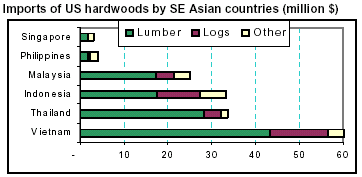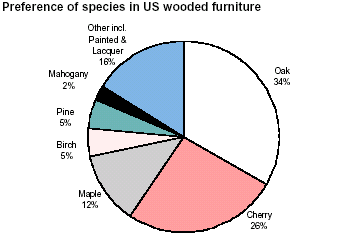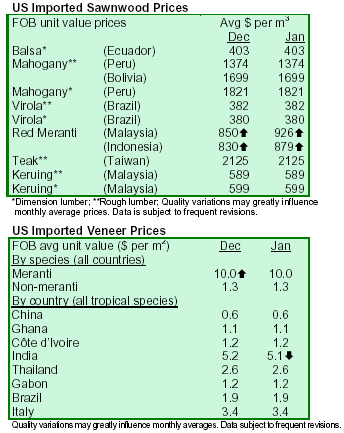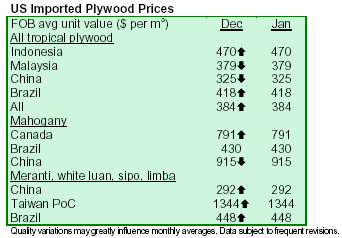|
US hardwood lumber exports to SE Asia booming
Total exports of US hardwood products to Southeast Asia moved ahead of the global trend (up 6.9%) in 2006,increasing 13% to $159 million, according to the
American Hardwood Export Council (AHEC). Lumber exports amounted to $110 million, up 32% from 2005 and
accounted for 69% of the total US hardwood product exports to the region. In contrast, log exports fell 25% and
accounted for less than 20% of the total value, whereas ten years ago logs were exactly half the value of lumber
shipments. All markets in Southeast Asia, with the exception of Singapore, now import more than half their
value of US hardwood imports as sawn lumber. Veneer shipments increased almost 15% and accounted for 9.6%
of total value. Together lumber and veneer accounted for almost 79% of the market value of US hardwood exports
in this region.stakeholders. The report is to be submitted to the Finance Committee within 15 months.

Vietnam has been the last, but fastest, country in Southeast
to adopt US hardwoods and is the region¡¯s leading lumber importer at $43.4 million. In Thailand, the total value
shipped was $33.4 million of which 84% was lumber at $28.3 million, the highest percent in any Southeast Asian
country. Indonesia has converted rapidly from a log market to a market for US hardwood lumber, now worth
$17.6 million out of a total of $32.4 million. In contrast, in 1998, logs there accounted for 61% of the then $29.3
million total. Malaysia is another market with a relatively high percentage of lumber, reflecting its position as one of
the world¡¯s largest furniture exporters with increasing need for imported lumber species. The Philippines market
remained very small and fell by 40% in total value in 2006, with lumber amounting to 57% of total products and
veneer 29%. Singapore¡¯s imports of US lumber climbed 160% to $3.8 million, but 36% of the import value was
veneer. The leading US species in Southeast Asia in 2006 by volume was white oak, followed by red oak. In
Vietnam, however, tulipwood was the most preferred species, whereas Thailand, Indonesia and Malaysia all
favour white oak.
ITC to investigate US flooring and plywood imports
US Senator Max Baucus, chairman of the Senate Committee on Finance, has asked the International Trade
Commission (ITC) to investigate and report on the competitive conditions affecting the US wood flooring and
hardwood plywood industries from 2002-2006, IWPA
informed. The action, brought under Section 332(g) of the Tariff Act of 1930, asks the ITC to review and analyze the
US markets and trade patterns; principal supplying countries (Canada, China, Brazil, Indonesia, Malaysia, and
Russia); factors affecting competition such as illegal
logging, labour and environmental standards, and government programs; and the supply of and demand for
these products by end-users, importers, and other stakeholders. The report is to be submitted to the Finance Committee within 15 months.
US imposes duties on Chinese glossy paper
The US Department of Commerce (USDC) announced that it would apply duties only on Chinese producers of
glossy, high-quality paper, used in books and magazines. This product accounts for $224 million of annual imports.
The move reverses 23 years of policy and opens the door to a possible rush of new trade complaints by US
manufacturers against their China-based competitors.
The move was in response to a complaint filed in October by an Ohio-based company,
NewPage Corp. The USDC found that Chinese companies benefited from low-cost
loans from state-owned banks, as well as grants and tax breaks given by various government bodies. By
determining that those are subsidies which can be countered by US trade measures, the USDC has created a
broad precedent that can be exploited by many other companies, according to observers. USDC preliminary
decision imposes duties ranging from 10.9% to 20.35% on the paper products at issue in the case. The department
also applied duties to imports from Indonesia and South Korea. Still, the case is not over, and several procedural
hurdles must still be cleared before the USDC can issue a final order for the duties. The process is expected to be
concluded late this year.
China¡¯s Ministry of Commerce criticized the USA for violating a consensus on resolving trade frictions through
dialogue. China demanded that the USA reconsidered the decision and corrected it as soon as possible. The Ministry
called the move ¡°unacceptable¡± to Chinese industry.
Wood species used in US furniture: oak dominates
On the occasion of the High Point Furniture Markets, the US trade magazine ¡°Furniture / Today¡± is conducting
sporadic surveys about the top-ranking wood species used in furniture production. The magazine calculates the
percent of respondents that indicate a particular species as the best-selling wood. The four top ranking species for all
US furniture categories combined are oak, cherry, maple and birch, in that order (see chart). Oak (red and white)
accounts for over one-third of the responses, followed by cherry (one-quarter), maple (12%) and birch (5%). Maple
and cherry are gaining market share, while red oak is loosing it. Tropical species rank very low, with only 2.4%
for mahogany and 0.4% for rubberwood. The usage of mahogany has been on a long-term declining trend, due to
restrained trade volumes after the listing of the species in CITES. A fairly large share (10.3%) is allocated to painted
wood and lacquered wood.
Taste varies by furniture category
There are some interesting variations between furniture categories. For instance, cherry is the most dominant wood
species for furniture used in master bedrooms and formal dining rooms, followed by oak. Oak is also popular for
casual dining room furniture, followed by birch, cherry
and maple. For youth bedroom furniture, painted wood takes a prominent second place, right after oak. Pine
furniture is also popular. The surveys also distinguished between price points, segregating low, mid and high
priced furniture. Cherry dominates in the upper-end furniture segment, helped by its current high prices. In the
mid and low-price range, oak remains the most frequently used wood.

Taste also varies by US region
There are also some interesting regional preferences. In the West and Mid-west, oak ranks at the top of the priority
list, followed by cherry. While maple is also sought after in the Mid-west, it plays a very subordinate role in the US
Western. In the North-eastern region, cherry is the wood
of choice, with oak and maple also important. In view of the abundance of softwood resources in the West of the
country, pine furniture capture the third most important spot in that region. Apart from the West, no other region
makes much use of pine in furniture production. Due to the shear size and purchasing power of the Southern USA,
accounting for approximately one-third of the entire country, marketers are paying close attention to consumer
preferences in this region. The number one furniture species is cherry, followed by maple and oak. The South
also seems to have a strong liking for painted furniture.


|